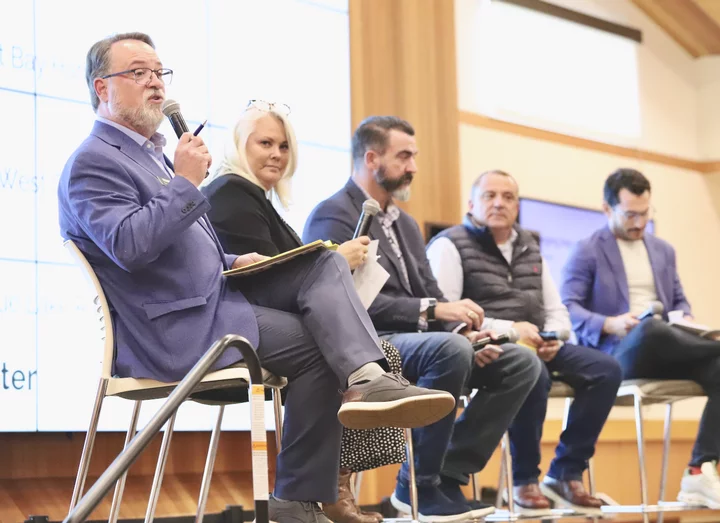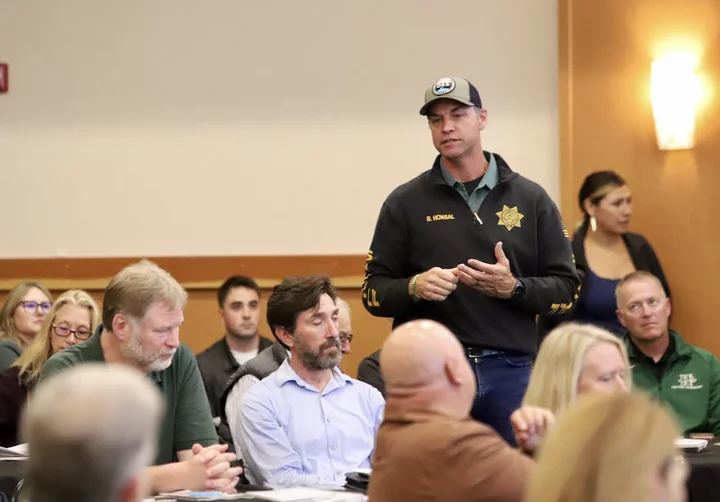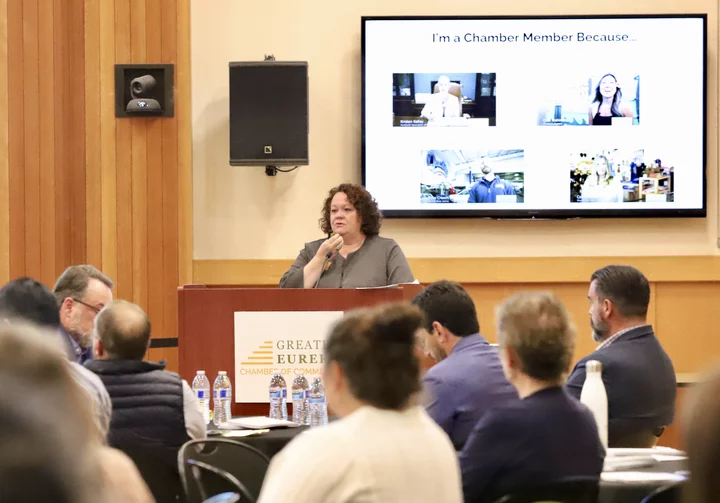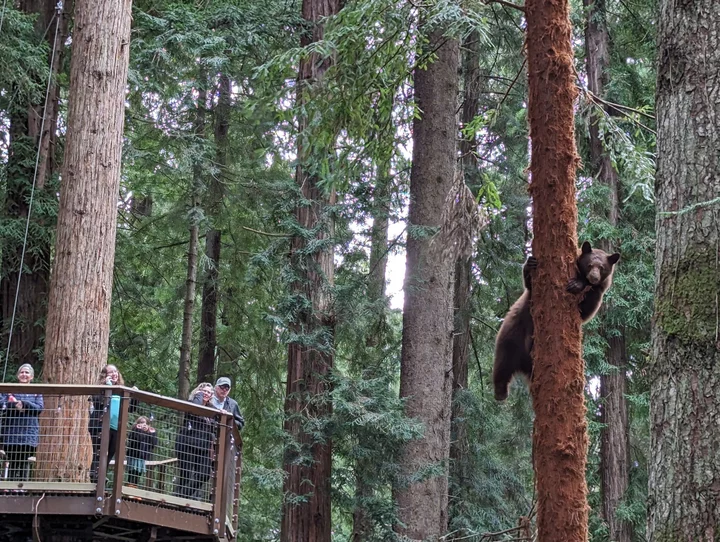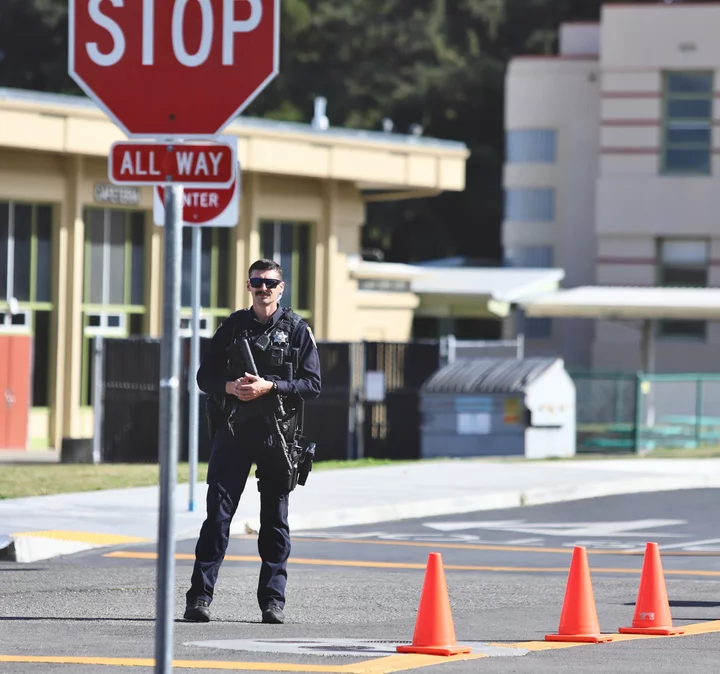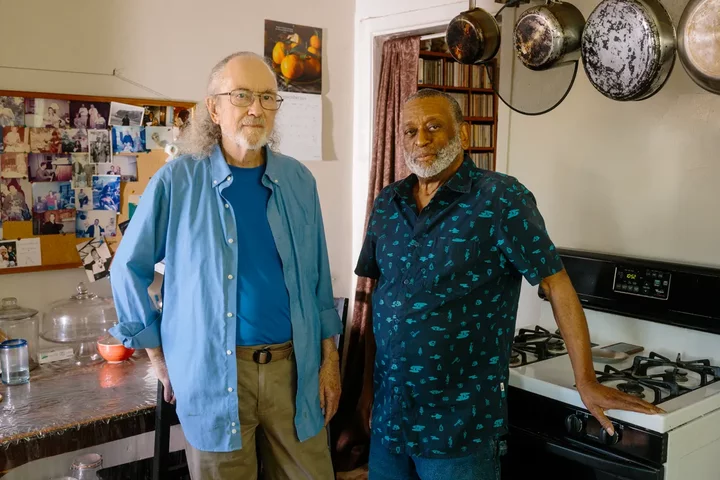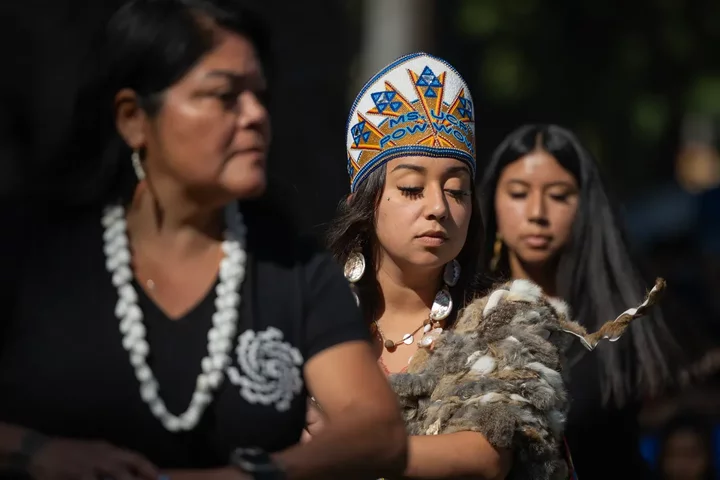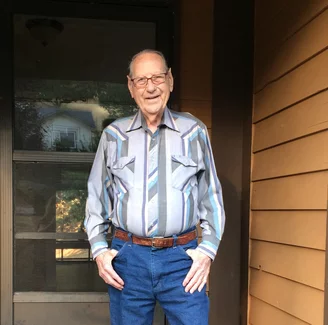‘We’ve Got to Move Forward’: Local Leaders, Business Owners Talk Offshore Wind, Renewable Energy at 2024 Economic Forecast
Isabella Vanderheiden / Thursday, Oct. 10, 2024 @ 3:34 p.m. / Economy , Infrastructure , Offshore Wind
The “emerging industries” panel (from left to right): Gregg Foster, Brenda Chandler, Jason Ramos, Chris Mikkelson and Erik Peckar. Photos by Andrew Goff.
###
On Wednesday afternoon, about 100 of Humboldt’s movers and shakers gathered at the Sequoia Conference Center for the Greater Eureka Chamber of Commerce’s 2024 Economic Forecast, an annual event focused on the local economy and emerging industries.
Turns out, there’s a lot going on here in Humboldt! The offshore wind industry is looking to build a massive floating wind farm off the coast of Eureka; the Humboldt Bay Harbor, Recreation and Conservation District is drawing up plans for a heavy lift marine terminal that would support offshore wind development; Nordic Aquafarms is wrapping up the permitting process for its land-based fish farm on the Samoa Peninsula; and the Blue Lake Rancheria is moving forward with yet another microgrid project.
Gregg Foster, executive director of the Redwood Region Economic Development Commission (RREDC), led a four-person panel discussion focused on emerging industries and the future of the local economy. He emphasized how far the county has come in the last 40 years, following the decline of “traditional industries” and the subsequent “period of rapid disinvestment.”
“There were some solutions that came out of that, such as investing in infrastructure to make us ready for the next wave, whether that be broadband, the airport, the Harbor District, or whatever else,” Foster said. “It’s refreshing to come to a conference like this where we’re looking at all these opportunities that are in front of us … and hearing directly from the businesses who are actually making commitments, who are actually spending money, who are actually bullish on their future here in Humboldt County.”
Brenda Chandler.
Brenda Chandler, U.S. CEO of Nordic Aquafarms, said the Norway-based company has all but wrapped up the permitting process for its onshore fish farm and is shifting its focus to site clean-up at the Harbor District-owned Redwood Marine Terminal II property.
“As most folks know, the very first step is site clean-up. There’s more work that needs to be done in terms of the site itself,” Chandler said. “We also need to get a better understanding of the subsurface and the network of pipes that exists below the surface. … By the beginning of the year, we’re hoping the site will be ready to begin demolition”
If everything goes according to plan, Nordic will begin construction in late 2026 or early 2027. Once that’s done, the company will enter a commissioning phase. “There’s a fairly lengthy commissioning process as we’re starting up the farm, which will probably carry over into 2028,” Chandler said. “Those are just general terms, and there’s a number of things that still need to fall into place. We’re looking to the future, but we’re sort of taking it one day at a time.”
To bring the project to life, Nordic will have to hire a workforce with a broad range of skills. They’ll need aquaculture experts, biologists, farmers, mechanical and technical engineers, salespeople and a variety of collaborators. “We will have a microcosm of an entire industry available here,” she continued. “There’s a lot of opportunity that is going to surround the farm. … It’s still a few months away, but we’re getting ready to turn this corner and really start outwardly engaging.”
Chris Mikkelson and Erik Pekkar.
The offshore wind industry is still several years behind Nordic. Erik Peckar, Vineyard Offshore’s West Coast director of external affairs, said the company is currently focused on getting to know the community and establishing local partnerships.
“Before I moved to the West Coast, I spent the better part of the last 13 years advocating for my community on Martha’s Vineyard … to bring investments into the local community and to help folks get trained for local jobs,” he said. “We want to make sure that we’re building partnerships with folks in the community … and we want to invest in the community. I don’t think it’s a secret that there’ll be tens of millions of dollars invested into these local communities. … We want to work with folks to build partnerships to make sure that that money is spent in a responsible manner.”
There will be thousands of wide-ranging jobs available in the coming years and decades, Peckar said. They’ll need folks to help construct the heavy lift marine terminal on the Samoa Peninsula and assemble the massive turbines that will be towed out to sea. And when construction wraps up, they’ll need a lot of other folks to maintain the turbines.
“The more that we can train locally here, the more that we can invest locally here and, I think the better off we are,” Peckar said. “That’s not to say that there won’t be folks coming from out of town to come work on these jobs – just being frank – but we want to build a local workforce.”
Chris Mikkelson, executive director of the Humboldt Bay Harbor, Recreation and Conservation District, talked a bit about the district’s role in offshore wind development and expressed enthusiastic support the project and the opportunities it would bring for locals.
“I didn’t come from a family that wanted to save the planet or the environment,” Mikkelson said. “I came from a family that wanted to log trees, ship lumber and get filthy rich … We have an opportunity to create better opportunities in our community and for our children.”
Jason Ramos.
Jason Ramos, CEO of business operations at the Blue Lake Rancheria, said the Tribe is hard at work on the Toma Resilience Campus, a training and innovation center that, once complete, will provide the four-county region with classrooms for emergency preparedness training, a “business incubator,” a commercial kitchen and a variety of other uses. Ramos said the Tribe is currently focused on the business incubation component of the project and will be seeking local business partnerships.
The Blue Lake Rancheria is also working with the Hoopa Valley Tribe, Karuk Tribe, Yurok Tribe, Redwood Coast Energy Authority, Pacific Gas & Electric Company and the Schatz Energy Research Center at Cal Poly Humboldt on the Tribal Energy Resilience and Sovereignty (TERAS) project. The TERAS project seeks to advance climate resilience and clean energy innovation in tribal communities throughout the North Coast.
“We’ve got to move forward,” Ramos said. “We have to move forward with job training and business innovation. We have to do something new.”
[DISCLOSURE: The Blue Lake Rancheria is a minority owner of the Outpost’s parent company, Lost Coast Communications, Inc.]
Humboldt County Sheriff Billy Honsal.
Offshore wind development faces one major obstacle: California’s aging electrical grid. State lawmakers are pushing legislation forward that aims to streamline wind and solar energy projects, but there’s still a long way to go.
During the Q&A period at Wednesday’s event, Humboldt Sheriff Billy Honsal expressed “major concerns” about offshore wind development efforts.
“I don’t know if we’re ready, as far as the infrastructure goes,” Honsal said. “Workforce development, housing – all those things are major concerns. We’re already struggling with the professional industries that are already here, such as Cal Poly Humboldt and Providence … I would love to be able to support you all in what you’re doing but we also have to come up with a plan to make your projects in our county a success.”
Peckar thanked Honsal for bringing up his concerns and emphasized that Vineyard Offshore wants to get a “full picture” of the community’s concerns to make “the best decisions we can in investing in this community.”
Nancy Olson.
Unfortunately, the keynote speaker couldn’t make it to the event. Robert Eyler, renowned economics forecaster and professor of economics at Sonoma State University, got stuck on an Arcata-bound plane due to weather conditions and had to head back to the San Francisco airport.
Nancy Olson, CEO of the Greater Eureka Chamber of Commerce, assured her membership that Eyler would provide an economic forecast for Eureka at a future meeting. Stay tuned!
BOOKED
Today: 12 felonies, 15 misdemeanors, 0 infractions
JUDGED
Humboldt County Superior Court Calendar: Today
CHP REPORTS
No current incidents
ELSEWHERE
Governor’s Office: Governor Newsom announces appointments 8.27.25
County of Humboldt Meetings: Humboldt County Fire Safe Council Quarterly Meeting Agenda - 08/14/2025
County of Humboldt Meetings: Humboldt County Fire Safe Council Quarterly Meeting Agenda - 08/14/2025
County of Humboldt Meetings: Fish & Game Advisory Commission Agenda - Zoom Meeting
Noni, Beloved Black Bear at Sequoia Park Zoo, Has Died
LoCO Staff / Thursday, Oct. 10, 2024 @ 12:13 p.m. / News
Noni the black bear. | Images via Sequoia Park Zoo.
###
The Sequoia Park Zoo posted the following on social media:
Sequoia Park Zoo is devastated by the loss of our beloved Noni bear.
On the afternoon of Wednesday, October 9, 2024, Noni was rushed to another emergency surgery to evaluate the severity of her condition. Even after the constriction had been removed and despite the life-saving efforts of her care team, it was discovered that the trauma to her colon was irreversible, and the organ had been unable to recover.Noni was found orphaned in Shasta County in early spring of 2022 and was taken to Lake Tahoe Wildlife Care for rehabilitation, and she met and bonded with another bear cub named Tule. When California Department of Fish and Wildlife determined that they were not suitable for release, Noni and Tule were placed at Sequoia Park Zoo where they would become ambassadors for their species and help educate guests about living with wildlife.
Animal care staff are giving Tule extra attention while he adjusts to this new normal, and they report that he is eating well and interacting with enrichment. However, we remind visitors that Tule might choose to spend more time in the patio and night house, and he might not always be visible to guests.
During her too-short time at the Zoo, Noni delighted staff, volunteers, and visitors with her silly antics and goofy personality. Noni particularly enjoyed playing in bubbles and splashing in water, and zookeepers often joked about needing to get her a hot tub for the backyard.
Noni was a truly beautiful bear with a gorgeous coat, long eyelashes, blonde eyebrows, and a perfectly heart-shaped nose that would wiggle as she sniffed out her favorite treats, including peanuts, yogurt, and honey.
Affectionately called “twinkle toes” by her caretakers, Noni would often perch herself on the thinnest branches at the top of the redwoods, while guests marveled at how she managed to balance so effortlessly.
Noni brought so much joy to our Zoo, and it is impossible to express the depths of our sadness at the passing of our sweet bear. These past few days have been incredibly difficult for the Zoo team, especially for Noni’s dedicated caretakers, and we appreciate the care and support shown by our community. The loss of a beloved member of our animal family has a profound impact that never gets easier, and we know that our community is mourning alongside us. Please consider sharing a favorite photo or memory of Noni below, and donations in Noni’s honor may be made to the Animal Enrichment Fund at redwoodzoo.org/donate.
We are so fortunate to have been able to care for Noni, and we will miss her deeply.
CHILD ABDUCTION: Humboldt County Sheriff’s Office Seeks Public’s Help Locating 4-Year-Old Hoopa Girl Missing Under ‘Suspicious Circumstances’
LoCO Staff / Thursday, Oct. 10, 2024 @ 11:24 a.m. / News
Press release from the Humboldt County Sheriff’s Office:
The Humboldt County Sheriff’s Office needs the public’s help to locate a child named Thompson Thompson, age 4 of Hoopa, who has been abducted under suspicious circumstances.
The child was reported missing by her court-ordered legal guardian on Oct. 9 after she was not returned from a scheduled visit with her father, Peter Thompson, on Oct. 5. The father is the last known person to have seen the child. He is only allowed scheduled court-ordered visitation and does not have any custody rights over his child.
Based upon the facts of this case, the Sheriff’s Office sought and obtained an arrest warrant for the father on Oct. 9 for Child Abduction (PC 278). The Sheriff’s Office also requested a Feather Alert for the missing child.
On the evening of Oct. 9, the father arrived at the Humboldt County Correctional Facility (HCCF) and turned himself in for the PC 278 warrant—he is currently in custody at the HCCF. The father claimed to know about the whereabouts of the child but refused to disclose information regarding her location to law enforcement.
The Sheriffs’ Office needs the public’s help in locating the child. The child is 4 years old, approximately 50 lbs, 3’7”, with brown hair and brown eyes. She was last seen wearing a black floral T-shirt, black pants, and cowboy boots.
Anyone with information for the Sheriff’s Office regarding Thompson Thompson’s possible whereabouts should call the Humboldt County Sheriff’s Office at 707-445-7251.
(UPDATING) Eureka High on Lockdown For the Third Time This Month, Following Another Threat
LoCO Staff / Thursday, Oct. 10, 2024 @ 11:18 a.m. / Emergencies
Photo: Andrew Goff.
UPDATE, 1:07 p.m.: An officer on the scene tells the Outpost’s Andrew Goff that the incident has been downgraded to “a soft lockdown,” meaning students are not hiding under their desks anymore. They are doing schoolwork and can be escorted to the bathroom if necessary.
A couple of minutes later, a mom standing outside the high school got a call from the school that ended with, “There is no active threat on campus,” Goff reports.
###
UPDATE, 12:31 p.m.: Police are inside Eureka High, but it’s not clear what is they’re doing. Parents are milling about, some chatting with cops on the perimeter. J Street is still closed.
“Hey, let us out of here!” one kid just yelled from a second-story window. “I’m going to piss myself!”
###
UPDATE, 11:36 a.m.: J Street is completely closed off, says the Outpost’s Andrew Goff. Officers with rifles are patrolling the perimeter of the school.
###
An Outpost reporter is en route to Eureka High, as the school has been hit with yet another threat — the third time this has happened so far in October.
From the Eureka Police Department’s Facebook page:
Eureka High School is currently on a lockdown due to a new threat that was brought to the attention of school administration. There are no indications of an immediate danger on campus. However, for the safety of students and staff, the lockdown has been initiated. The Eureka Police Department is on the scene and has secured the school and is currently conducting an investigation into the legitimacy of the threat. All students are safe. Please do not come to the school at this time allowing EPD to concentrate on the investigation. We will provide updates as permitted by law enforcement. For more information please follow on EPD social media.
California Pledged $500 Million to Help Tenants Preserve Affordable Housing. They Didn’t Get a Dime.
Felicia Mello / Thursday, Oct. 10, 2024 @ 7:34 a.m. / Sacramento
Luke Johnson and husband Osbey Jackson in the kitchen of their longtime home in the Silver Lake neighborhood of Los Angeles on Oct. 5, 2024. Photo by Stella Kalinina for CalMatters
Luke Johnson and his neighbors thought they had found the perfect solution to avoid being displaced from their Silver Lake, Los Angeles fourplex: A state program was offering $500 million to help tenants, community land trusts and other affordable housing developers buy buildings at risk of foreclosure.
With their longtime landlords set on selling the building, Johnson and his neighbors persuaded them to sell to a community land trust that pledged to keep rents low.
But six months later, the state program has vanished after failing for three years to give out any of the grants and loans it promised. The deal with their landlords has collapsed. That leaves Johnson, 85, and his husband unsure whether they’ll be able to stay in the rent-controlled two-bedroom apartment where Johnson has lived for nearly half a century.
The sudden disappearance of half a billion dollars of state money meant to help community land trusts has left some housing advocates questioning California’s commitment to preserving existing affordable housing, a strategy that’s less flashy than building new units but can also be less expensive.
“It’s a struggle for us and I’m sure for a lot of other people who counted on getting that grant and didn’t get it,” Johnson said.
State lawmakers created the Foreclosure Intervention Housing Preservation Program in 2021. It was a watershed moment for community land trusts, nonprofits that purchase land and preserve it as permanently affordable housing by renting or selling the buildings on it to low- and moderate-income residents. Residents then manage the property cooperatively.
While community land trusts have tripled in number in California over the last decade, springing up everywhere from coastal and inland cities to tribal lands and the Mexican border, they often struggle to raise enough money to compete with private developers. Access to a dedicated pot of state money was poised to be a game-changer for both the trusts and cities seeking to prevent displacement of low-income residents, said San Francisco Supervisor Dean Preston.
“We had hoped the state would help San Francisco and other cities that want to really ramp up these programs,” Preston said. “(Community land trusts are) a very effective, quick and permanent way of creating truly affordable housing with resident control.”
The state planned to dole out the half-billion dollars in loans and grants over five years, funding purchases of financially distressed buildings of up to 25 units.
Three years in, however, the state agency charged with developing the program, the Department of Housing and Community Development, had yet to give out a single dollar.
This spring, with California facing a projected $56 billion budget deficit, some lawmakers began raising concerns.
“It’s the kind of thing that you look at and it makes your head explode,” Assemblymember Jesse Gabriel, who chaired the Assembly’s budget committee, said in an interview. “This is something of importance to everyone in California, and yet we’re sitting here with this tremendous allocation of resources and making zero progress. That is totally unacceptable.”
Lawmakers scrapped the program in June.
It wasn’t the only state spending on the chopping block this year. But community land trust advocates complained that the state’s slow rollout undermined the program before it could get started.
“We got into the 2021 budget expecting the funds would be available within a year or year and a half,” said Leo Goldberg, co-director of policy at the California Community Land Trust Network. “If the program had been rolled out, there would have been successes to point to that would have made it easier to defend.”
Three years in, zero progress
Johnson said he immediately felt at home in the diverse Silver Lake of the 1980s, with its vibrant and organized LGBTQ community, Latino families socializing on porches and Russian immigrants filling Orthodox churches. Over the last 40 years, he’s watched the neighborhood gentrify as hipster professionals moved in, bringing their cash with them.
Johnson’s now-husband, Osbey, came to house-sit in 1990 and never left. They and their neighbors, friends who have all lived in the building for at least a decade, hosted community events in the complex’s back garden.
When their landlord signed a contract to sell the building to a for-profit developer, they feared displacement. Average rent for a two-bedroom in Silver Lake had ballooned over the years to nearly $4,000 per month, according to Zumper.com, about four times what Johnson and his husband currently pay.
After he and his neighbors, one of whom had experience organizing with the Los Angeles Tenants Union, launched a phone and email campaign, the private developer backed away from the deal and their landlord agreed earlier this year to sell to the Beverly-Vermont Community Land Trust, giving the trust until this month to raise the $1.5 million purchase price.
That should have worked: California was expected to start distributing the affordable housing preservation funds this year. Land trusts were already having initial conversations with the fund manager selected to run the program about projects that would be eligible.


First: The communal backyard of the multifamily building that Luke Johnson and his husband Osbey Jackson have called home for decades in the Silver Lake neighborhood of Los Angeles on Oct. 5, 2024. Last: The kitchen of Luke Johnson and husband Osbey Jackson in their Silver Lake home in Los Angeles on Oct. 5, 2024. Photos by Stella Kalinina for CalMatters

From left, Osbey Jackson and husband Luke Johnson on the deck of their longtime home, which is part of a multifamily building in the Silver Lake neighborhood of Los Angeles, on Oct. 5, 2024. Photo by Stella Kalinina for CalMatters
But by July the expected state support was off the table. The clock was ticking to find a backup plan. The residents started an online crowdfunding campaign and threw a backyard fundraiser with barbecue and a drag show. The land trust pitched the project to small banks and credit unions.
Even if the trust got approved for a loan, the interest on a private loan would likely be much higher than using state money, foiling the tenants’ plans to keep their rent affordable. Kasey Ventura, an organizer with the land trust who had negotiated similar deals, estimated rents on the units would need to rise to at least $2,000 a month — still below market rate, but a significant jump.
The loss of the state fund was a “huge setback” for not only the Silver Lake tenants, but community land trusts across the Los Angeles area who had been banking on the support, Ventura said.
“We have dozens, if not hundreds of units that are in this bubble now of ‘How do we do this?’” Ventura said.
Why did this program take so long to roll out?
New government programs often take months, if not years, to roll out. But even by state standards, the glacial pace of the Department of Housing and Community Development’s launch of the housing preservation program stands out.
The state housing department declined to make anyone available for an interview for this story. But in an emailed statement, spokesperson Alicia Murillo said the unprecedented nature of the housing preservation program created a steep learning curve for agency staff.
The program “was very different from any other program HCD manages, both in terms of the types of projects (small-scale acquisition/rehab vs. our usual larger-scale new construction) and in terms of the mechanism for fund disbursement (using external nonprofit lenders rather than disbursing funds ourselves),” Murillo wrote.
Another state effort to create housing stability for low- to moderate-income Californians, created at the same time, launched much more quickly: Lawmakers authorized California Dream for All, a downpayment assistance plan that covers up to 20% of a home’s cost for certain first-time homebuyers, with the same 2021 budget bill that created the housing preservation program.
Less than two years later, the California Housing Finance Agency, a different arm of the state bureaucracy, had already given out all $288 million in initial Dream for All funding to eager homebuyers. This year, the agency overhauled Dream for All to serve a more diverse set of buyers; the revamped program survived state budget cuts and awarded an additional $250 million in no-interest loans.
“It’s the kind of thing that you look at and it makes your head explode.”
— Assemblymember Jesse Gabriel, Democrat from Encino
By contrast, the state housing department took a year to draft guidelines for the housing preservation program, then another eight months to turn those into final rules. The plan called for a nonprofit fund manager to run the program, but the state didn’t award that contract until July of 2023, two years into the program’s five-year timeline.
That’s unusual, said Ben Metcalf, managing director of UC Berkeley’s Terner Center for Housing Innovation, who led the state housing department from 2015-2019. While it can easily take two years to launch a new program, he said, that timeline can shrink by a year if lawmakers have already appropriated the money, as they had for the housing preservation program. And things can move even faster, he said, “when an agency or director is motivated, or you have the right staff to implement it.”
Housing department spokesperson Pablo Espinoza said by email that part of the delay stemmed from the need for changes to state law that would allow officials to transfer money to the fund manager and pay its administrative expenses. It took several months for those adjustments to pass the Legislature, he said. California Dream for All didn’t face those hurdles, he said, because it was administered similarly to the Housing Finance Agency’s existing loans.
To design the housing preservation program, the department did “a ton of outreach” to community land trusts and others involved in preserving affordable housing, said Elizabeth Wampler, Bay Area executive director for the Local Initiatives Support Corporation, the fund manager awarded the contract.
Wampler’s group was drawn to the project after lending money to community land trusts to preserve affordable housing in the Bay Area, she said.
“We saw those deals had incredible impacts for communities of color,” Wampler said. “We know it’s a huge anti-displacement strategy to keep people in their homes. It helps to increase affordable housing stock — there are a lot of reasons why it’s a good strategy.”
“We got into the 2021 budget expecting the funds would be available within a year or year and a half. If the program had been rolled out, there would have been successes to point to that would have made it easier to defend.”
— Leo Goldberg, co-director of policy, California Community Land Trust Network
Affordable housing groups had identified 162 buildings they hoped to buy and preserve as affordable using the state funds, according to a survey Wampler conducted.
But the state’s design process took so long that by the time it was complete, the state budget picture had changed and the department never signed a contract with Wampler’s group. Instead, the department put the program on pause in late 2023 — at least six months before lawmakers officially cut its funding.
“I think it was hard that the program hadn’t launched and hadn’t funded any projects,” Wampler said. That made it a target for lawmakers looking to save money, she said. “I think everybody involved was like, ‘Oh god, why didn’t we just get it done six months ago — we would have been in such a different position.’ ”
The department did already have some experience with affordable housing preservation through another program designed to help mobile home park residents and nonprofits buy and fix up parks. Like the housing preservation program, the Manufactured Housing Opportunity and Revitalization Program provides loans to purchase existing properties, some of them with fewer than 25 units. Both aimed to support residents banding together to manage their housing cooperatively.
Between 2013 and 2023, the department only approved a single loan application for the mobile home park program, CalMatters reported last year. But lawmakers have since redesigned it, and in 2023 the department awarded more than $100 million to indigenous tribes, local governments, resident cooperatives and nonprofits like Habitat for Humanity.
Community land trusts seek big bank buy in
Last year, while the Foreclosure Intervention Housing Preservation Program languished, more than 13,000 California properties that would have been eligible for the program received a notice of default, according to a California Community Land Trust Network analysis of Property Radar data.
Among the state’s distressed properties was Oakland’s Warriors House, a local landmark near the 580 freeway painted in the splashy blue-and-gold color scheme of the Golden State Warriors basketball team and festooned with team memorabilia.
Owned by a local family for more than 50 years, the house needed extensive repairs when the family’s matriarch passed away after taking out a reverse mortgage, said Steve King, executive director of the Oakland Community Land Trust. The trust had hoped to use the state program to buy the home, both preserving the iconic property as affordable housing and preventing the woman’s son from being displaced, King said.
But without state support, the trust did not raise enough money in time, King said. A bank took possession of the property and sold it to a private buyer last year. The woman’s son, Lloyd Canamore, passed away shortly before the sale after moving to a rental in a different part of the city.
“It really messed him up,” said Michelle Easley, a neighbor who recalled Canamore as “a sweet man” who loved sports, his dogs and taking pictures with fans who would stop by the house.
“We’ve encountered similar situations of houses in probate, longtime Black families losing the family home, and it’s devastating,” King said.


First: Golden State Warriors fan Lloyd Canamore waves at people passing by his Warriors-themed home on 35th Street in Oakland, on July 9, 2020. The Oakland Community Land Trust had hoped to use state funds to buy the property so Canamore could stay in it. Photo by Ray Chavez, Bay Area News Group Last: The formerly iconic Warriors House, shown here in 2024, was sold to a private buyer last year after a bank repossessed it and Canamore passed away. Photo by Florence Middleton, CalMatters

The iconic Warriors House, formerly painted blue and yellow to honor the Golden State Warriors, in Oakland on July 22, 2024. Photo by Florence Middleton, CalMatters
In 2020, concerns about private equity firms buying distressed properties and converting them to market-rate rentals led to the passage of a state law that gave tenants whose foreclosed homes were sold at auction — or nonprofits working with those tenants — 45 days to match the winning bid.
But tenants and community land trusts still struggled to come up with funds to take advantage of the law. The housing preservation program aimed to change that.
“Time will tell whether the agencies can respond fast enough, but the reason I believe the governor agreed to this funding is that no one wants to have homelessness go up due to foreclosures,” Sen. Nancy Skinner, a Berkeley Democrat who championed the auction change, told online news outlet Next City at the time.
Skinner declined to comment for this story.
Preston, the San Francisco supervisor, said he thought elected officials at the state and federal level underestimated the importance of preserving existing affordable housing. Building new housing is important, he said, but so is stemming the constant hemorrhage of affordable units as they are purchased and flipped to luxury abodes out of reach of many Californians.
“It’s not production in terms of building something from the ground up, but it is producing when you take something that would otherwise be renting for $4,000 a month and instead have it renting for a reasonable percentage of someone’s income who is low-income,” he said. “That is creating affordable housing for working-class people who otherwise wouldn’t be able to afford to live in San Francisco.”
Without state support on the horizon, community land trusts across California are now pooling their efforts to create a joint capital fund, powered by philanthropy and private banks, that could eventually provide low-interest loans to buy buildings like the one in Silver Lake.
They’re hoping banks will be attracted by the opportunity to fulfill some of their obligations under the federal Community Reinvestment Act, which requires financial institutions to prove they are meeting the credit needs of historically disadvantaged communities.

The multifamily building that Luke Johnson and his husband Osbey Jackson have called home for decades in the Silver Lake neighborhood of Los Angeles on Oct. 5, 2024. The building’s tenants are looking for a way to buy the property after a state program that they hoped would fund the purchase collapsed this year. Photo by Stella Kalinina for CalMatters
The goal is to create a one-stop shop for lenders who want to support community ownership, raising $20 million in 2025 and eventually growing that to $100 million that community land trusts could combine with public subsidies to buy properties, said Jazmin Segura of the Common Counsel Foundation, which is hosting the fund.
Johnson and his husband still hope they won’t have to leave their home. The deadline to put down a deposit on the Silver Lake building came and went, with the land trust unable to come up with a Plan B that would have raised the money any sooner than next year. He and his neighbors are asking their landlords for more time to come up with a solution.
If they don’t succeed, Johnson fears he and his husband would have to leave Silver Lake.
“We really don’t know what the future is,” Johnson said.
###
CalMatters.org is a nonprofit, nonpartisan media venture explaining California policies and politics.
The Brutal Story Behind California’s New Native American Genocide Education Law
Carolyn Jones / Thursday, Oct. 10, 2024 @ 7:26 a.m. / Sacramento
Ms. UCR Powwow Princess 2023-24, Tishmal Herrera, dances at a performance during Native American Celebration Day at the state Capitol in Sacramento on Sept. 22, 2023. Photo by Miguel Gutierrez Jr., CalMatters
In the 1860s, an armed militia swept into the historic land of the Serrano people in the San Bernardino mountains and went on a killing spree, attempting to slaughter the entire tribe. A tribal leader named Santos Manuel led the surviving 30 members to safety in a nearby valley.
Now, Manuel’s great-great grandson has ensured that every K-12 student in California will learn the story of the Serrano people and other California native tribes who endured atrocities during the Spanish colonial and Gold Rush eras in California history.
“The hope is that students learn the true history of California, the horror and the genocide, but also the resiliency of the Indian people,” said Assemblymember James Ramos, a descendent of Manuel who authored a bill requiring schools to teach about the mistreatment and perspectives of Native Californians in social studies classes.
“It’s time that the voices of California’s first people drive the educational process, especially when the subject is our ways, our people, our history,” said Ramos, who lives on the San Manuel Indian reservation in San Bernardino County and is the first Native Californian to serve in the state Legislature.
Gov. Gavin Newsom signed the bill in September. It goes into effect Jan. 1.
Expanding fourth grade history curriculum
The new law will be most relevant to fourth-graders when they study California history, exploring the stories of California missions, the discovery of gold and statehood — all of which had a profound impact on the indigenous people who’d lived in the region for at least 20,000 years.
The current fourth grade history curriculum covers the plight of Native Californians but it’s only recommended, not required. As a result, lessons vary across school districts, with some students getting scant information – or lessons focused largely on the missions. Under Ramos’ law, lessons on the mistreatment of Native Californians will be mandatory. Some of the information may also be covered in California’s new ethnic studies requirement for high school students, which goes into effect in fall 2025.
Tribal leaders said they were pleased with the bill, but hope students learn more about Native California history than just the tragedies. Ideally, they said, students should be learning the full breadth of Native history and culture: learning basket techniques in art class, reading Native authors in literature class, studying Native healing practices in health and science classes, and learning Native approaches to environmentalism, politics and economics throughout the entire curriculum.
They’d also like to see schools develop relationships with local tribes, inviting members in to teach the tribe’s history, language and traditions. Students should learn at least some phrases in the local indigenous language, and the school should promote Native culture at every opportunity, they said.
“These stories matter for all Californians,” said William Bauer, a history professor at UC Riverside who specializes in Native Californian studies and is a member of the Round Valley tribe. “I’d hope kids leave school with the idea that California Indians have survived and thrived.”
“The hope is that students learn the true history of California, the horror and the genocide, but also the resiliency of the Indian people.”
— Assemblymember James Ramos, Democrat from San Bernardino
Shannon Rivers, manager of the nonprofit Indigenous Education Now, a Los Angeles advocacy group, said the bill is much needed, but schools also need to do a better job specifically serving Native students, many of whom are struggling.
Native students lag behind the state average in nearly every measurement, including attendance, graduation rates, math and literacy scores and discipline. One solution, Rivers said, is to create special programs for Native students that focus on their history, language and traditions, which could boost students’ interest in school and help make curriculum more relevant to their lives. His group is currently working with Los Angeles Unified on such a plan.
“It’s important we do this, so Native students have a better understanding of who they are,” said Rivers, a member of the Akimel O’otham tribe in Arizona. “Although the challenge with all these initiatives is that Native people are not monolithic. They’re incredibly diverse, especially in California.”
Disease, enslavement, killing
When Spanish missionaries arrived in the late 1700s, at least 300,000 people lived among an estimated 200 tribes scattered in every part of California, making it one of the most densely populated and diverse regions in North America.
But Native numbers began to decline with the arrival of Spanish missionaries, who brought diseases for which Natives had no immunity, including smallpox, malaria and diphtheria. The Spanish also introduced crops and livestock that altered the landscape and created food shortages for tribes. Thousands of native people died when they became enslaved or imprisoned at the missions, where they were forced to work in the fields and convert to Catholicism.
But the most violent period followed the discovery of gold in the Sierra foothills in the mid-1800s. Settlers, private militias and the U.S. troops carried out massacres across California, with the intent of exterminating the Native population. By 1900, only about 16,000 Native Californians remained, many living in small groups away from their original homeland.


First: An illustration of Native Americans belonging to the Ohlone, which lived along the coast of California, stretching from San Francisco Bay to the lower Salinas Valley. This image is a reproduction of a painting by George H. Langsdorff done in 1806. Last: Four Mono native women sit outside of a bark hut. Bark huts were traditionally built for winter habitation and provided protection from rain, snow and wind. Images via the California State Library
Over the next century, the population gradually rebounded and Native people nurtured their culture and traditions, despite being subject to abuse at government-run boarding schools, discrimination, and legal fights over land ownership. By 2020, there were about 1.4 million Californians who identified as at least part Native American, according to the U.S. Census.
The violent history may be difficult to digest, especially for younger children, but schools should find thoughtful, sensitive ways to impart the full story of Native Americans in California, said Joely Proudfit, head of the Native American studies department at Cal State San Marcos.
“The history of California is tragic. It’s brutal. It’s violent. Genocide occurred here,” said Proudfit, who is both Payómkawichum and Tongva, tribes that are indigenous to Southern California. “We need to be honest about our history, so maybe we’ll have some compassion and empathy with what’s happening in today’s world.”
“We need to be honest about our history, so maybe we’ll have some compassion and empathy with what’s happening in today’s world.”
— Joely Proudfit, head of the Native American studies department at Cal State San Marcos
She said that high-quality teacher training will be key in making Ramos’ bill a success. Even though the bill does not come with funding, she said the state should set aside money to help teachers learn the material and find effective ways to present it. Currently, Proudfit helps run a nonprofit called California Indian Education for All that provides free and low-cost training for teachers on how to teach about the history, culture and contributions of Native Caifornians. But the task should not rely solely on volunteers, she said.
“A state like ours, with its rich diversity of tribes, is going to need millions upon millions of dollars to create quality curriculum,” Proudfit said. “Asking cultural knowledge-keepers and professionally trained educators to continue to do these things for free is not appropriate. It’s a cultural taxation.”
‘Innocent bystanders’
In San Bernardino County, where Ramos’ family has lived for hundreds, if not thousands of years, the story of the 1860s massacre remains fresh. According to documents provided by the San Bernardino Historical and Pioneer Society, the Serrano tribe did not provoke the attack, “they really were innocent bystanders,” said Lyn Killian, a librarian with the historical society.
Four young Paiute Indians from Utah, who had come west with a wagon train, became involved in a tit-for-tat skirmish with some local cowboys that resulted in several deaths and, according to local historians, the Piutes burning a sawmill. For revenge, an armed posse stormed into the Serrano village — even though the Serranos were not involved in the fighting — and chased the inhabitants to Chimney Rock, near Lucerne Valley.

Assemblymember James C. Ramos’ great-great-grandfather, Santos Manuel. Photo courtesy of Assemblymember James C. Ramos
“Despite their cover in the rocks the Indians were wiped out,” according to a 1966 report by a local historian in the San Bernardino Sun-Telegram newspaper. “Posse men went on to destroy the nearby Indian village, even killing women and children. … The peaceful Serrano had taken no part in the mill burning but they were driven from their ancestral home nonetheless.”
After the bloodshed, the remaining members of the tribe moved around the valley, pushed further and further east as more settlers arrived. In 1891, the federal government granted them a reservation and recognized their sovereignty. Last year, the San Manuel tribe had about 200 members, a casino, resort and charity that provides scholarships, after-school programs, housing assistance, environmental restoration, arts and music programs and support for other tribes, among other causes.
“This history is still very much real to all of us, all California Indian people,” Ramos said. “With this bill, we have a chance to share the true accounts of what happened to us. And also that we’re still here, even though we were almost wiped off this earth. I sit now in the state Legislature with Serrano and Cahuilla blood in my veins. … That’s a story people should know.”
###
CalMatters.org is a nonprofit, nonpartisan media venture explaining California policies and politics.
OBITUARY: Richard Paul Etcheverry, 1926-2024
LoCO Staff / Thursday, Oct. 10, 2024 @ 6:56 a.m. / Obits
Richard Paul Etcheverry passed away peacefully on June 14, 2024, at
the age of 97 in Roseburg, Ore. He was born on August 2, 1926, in San
Mateo, Calif. He attended St. Matthews Elementary School and San
Mateo High School until his senior year, when he transferred to
Commerce High School in San Francisco, where he graduated six months
early in February 1944. After graduating high school, he enlisted in
the Navy at age 17 instead of being drafted into the Army at age 18.
Richard served in the Navy during World War II serving in the Pacific Theater and was honorably discharged in June 1946.
After returning home from the war Richard embarked on his career in Real Estate with the State of California Division of Tax Deeded Lands in Sacramento. While working, he attended night school for two years at UC California to earn his certificate in Real Estate Practice, Law, and Appraisal. His work with Tax Deeded Lands required much travel throughout the state of California. He decided when his oldest daughter was school age to settle down, so she could attend school on a regular basis. Richard then went to work in Redwood City as a title officer.
In 1967 Richard wanted a different lifestyle away from the crowded Bay Area and moved to Ettersburg in Humboldt County to follow his dream of sheep ranching. He soon found out the sheep ranch didn’t provide the income he expected and went to work as a title officer in Eureka, where he worked until 1980. He then decided to work closer to home and took a job as a bookkeeper at Whitethorn Construction until he retired in 1989. In addition to bookkeeping, he helped with real estate transactions.
After retirement Richard moved back to Eureka, where he enjoyed the company of friends at Humboldt Senior Center and for several years was a member of Goldenaires, singing at several local venues during the holidays. Richard loved to plan and map out many road trips, many of them for more than a month at a time. He traveled by car all over the United States sightseeing, hiking, and exploring each destination. He traveled to Europe, by himself at almost 93 years old, making many friends along the way.
IN MEMORY OF: He was preceded in death by: Mother, Margaret Meyer Greer; Father, Walter Etcheverry, Sr; brother, William (Sonny) Etcheverry; brother, Walter J. Etcheverry; companion, Barbara Denny; granddaughter, Misty Cooper; son-in-law, Ray Lindberg.
SURVIVING CHILDREN: He is survived by his six daughters: Margaret (Joe) Spatafore, Teresa Lindberg, Yvonne Moffett, Giselle Espinoza, Celeste Etcheverry (Scott Greenhow), and Mary Cooper. Companion children: Donna (Bill) Hollenshade, Diane (Jim) Cralle.
SURVIVING GRANDCHILDREN AND GREAT-GRANDCHILDREN: Joey Spatafore, Tricia (Mike) Rodriguez, Crystal (Jan) Dieffenbach, Stacie (Paul) Cabral, Nicolas Carpenter, Anthony Espinoza, Heather Espinoza, Martin Cooper, Anthony Boyd, Jon (Jamie) Boyd, Ben Boyd. Great Grandchildren: Kayla Rodriguez, Amber Dieffenbach, Emily Dieffenbach, Breanna Uyeno, Brandon Uyeno, Otto Boyd, Taylor Boyd, Hunter Boyd, Ryan Cabral, Mariah Cabral. Great Great Granddaughter: Penelope Uyeno.
Graveside service will be held at Oceanview Cemetery, Eureka, on October 19, 2024, at 10 a.m.
###
The obituary above was submitted on behalf of Richard Etcheverry’s loved ones. The Lost Coast Outpost runs obituaries of Humboldt County residents at no charge. See guidelines here. Email news@lostcoastoutpost.com.

